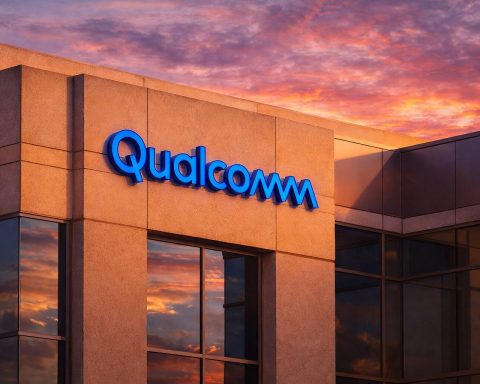Dell Technologies Inc. (NYSE: DELL) is trading lower on Tuesday as Wall Street counts down to the company’s fiscal Q3 2026 earnings release after the closing bell. The stock is caught between powerful AI‑driven growth expectations and mounting worries about a squeeze on hardware margins from surging memory costs.
DELL stock price today: trading below recent highs ahead of earnings
As of mid‑afternoon trading on November 25, 2025, Dell Technologies shares were changing hands around $126—roughly 1% lower on the day. [1]
Key trading stats today:
- Intraday range: approximately $123–$127
- Previous close: about $127.22
- Volume: just over 6 million shares, slightly below the typical daily average of roughly 7–7.5 million shares. [2]
- 52‑week range:$66.25–$168.08 – Dell is still about 90% above its 52‑week low, but roughly 25% below its 52‑week high, underscoring how far the stock has pulled back since the AI euphoria peak earlier in the year. [3]
According to Reuters, Dell shares remain up roughly 10% year‑to‑date, lagging the S&P 500’s ~15% gain as investors reassess how much AI‑server optimism is already priced in. [4]
Valuation snapshot:
- Market cap: about $85 billion
- Trailing P/E: ~18.4
- Forward P/E: ~12.2
- Dividend:$2.10 per share annually (yield around 1.6–1.7%) with the latest ex‑dividend date on October 21, 2025. [5]
What Wall Street expects from Dell’s Q3 FY26 earnings tonight
Dell will release fiscal Q3 2026 results this evening, followed by a conference call at 4:30 p.m. ET (3:30 p.m. CST). The company confirmed that it will publish the numbers before the webcast, which will be streamed via its investor relations site. [6]
Consensus expectations, based on LSEG and other analyst estimates, point to another quarter of solid top‑ and bottom‑line growth: [7]
- Revenue: about $27.1–27.13 billion, up roughly 11% year over year (vs. $24.37 billion a year ago).
- Adjusted EPS: around $2.47, compared with $2.15 in the prior‑year quarter.
The earnings narrative is shaped heavily by what Dell did last quarter:
- In Q2 FY26, Dell posted $29.8 billion in revenue, up 19% year over year, with net income of roughly $1.16 billion, and raised its full‑year outlook. [8]
- Dell also highlighted a surging AI infrastructure pipeline, with around $5.6 billion in AI server orders and $8.2 billion in AI server shipments in Q2, and it guided for about $20 billion in AI server shipments for FY26. [9]
Tonight’s call is expected to focus on three things:
- AI server momentum: Are AI orders and shipments still accelerating, and does Dell keep or raise that ~$20B AI server guidance?
- Gross margin resilience: How much of the recent spike in DRAM and NAND prices is already hitting margins?
- PC & storage trends: Whether Client Solutions (PCs) has stabilized and whether Infrastructure Solutions (servers and storage) can grow without an outsized margin hit.
AI tailwinds vs. memory‑cost headwinds: the core Q3 story
Several recent analyses frame Dell’s Q3 report as a classic “good news, bad news” scenario:
- Good news: Dell has emerged as a key AI infrastructure vendor, supplying high‑end servers powered by NVIDIA chips, and claims leadership in enterprise AI deployments. [10]
- Bad news: A sharp memory‑price super‑cycle is driving up the cost of DRAM and NAND, threatening profitability for PC and server makers such as Dell and HP. According to Morgan Stanley and others, DRAM prices have soared well over 150% and NAND around 50% in recent months, putting pressure on hardware gross margins. [11]
An Investing.com preview notes that investors will be watching how Dell protects margins while shipping more AI servers—a product category that tends to carry lower gross margins than high‑end storage or software, even as it drives headline growth. [12]
At the same time, Dell and NVIDIA recently announced expanded capabilities for the “Dell AI Factory with NVIDIA”, promising simpler, more automated deployments for enterprises across traditional and agentic AI workloads. These enhancements, unveiled in mid‑November at the SC25 conference, include integrated infrastructure, automation, and validated solutions aimed at speeding up AI adoption while tying in Dell’s high‑margin storage and networking offerings. [13]
The net result: Top‑line growth looks strong, but margin guidance, especially into fiscal 2027, is the key swing factor for how the market reacts tonight.
Analyst moves today: BofA trims its target, Aletheia turns more cautious
November 25 has brought a fresh wave of commentary on Dell ahead of the print:
BofA Securities: still a Buy, but more cautious on margins
A BofA Securities note, highlighted this morning, cut Dell’s price target from $170 to $160 while reaffirming a Buy rating. The firm:
- Cites rising DRAM and NAND prices as a medium‑term headwind.
- Models modest operating‑margin compression in Dell’s Infrastructure Solutions Group (ISG) and a steeper hit in Client Solutions Group (CSG) by fiscal 2027.
- Expects Q3 results to land roughly in line with current guidance and Street estimates, with only limited near‑term impact from memory inflation due to inventory timing and cost controls. [14]
BofA’s bottom line: Dell is still early in its AI adoption cycle, but investors should be realistic about how much of that upside might be offset by component costs over the next couple of years.
Aletheia Capital: downgrade to ‘Hold’ ahead of earnings
Separately, Aletheia Capital downgraded Dell to Hold ahead of Q3, flagging valuation and margin risk after the stock’s big run earlier in 2025. The firm’s report, covered by TipRanks today, points to: [15]
- A more balanced risk‑reward profile at current levels.
- Uncertainty around how much Dell can pass higher memory costs through to customers.
- The possibility of guidance that is solid but not spectacular relative to expectations.
The hangover from Morgan Stanley’s double downgrade
Dell’s stock has spent much of the past week digesting a high‑profile double downgrade from Morgan Stanley, which cut its rating from Overweight to Underweight and slashed its price target from $144 to $110. [16]
Key points from that call:
- Memory boom, hardware pain: Morgan Stanley argued that the current memory upcycle—great for suppliers like Micron—could significantly erode PC and server OEM margins, particularly for Dell and HP. [17]
- AI’s mixed impact: While AI servers are driving robust revenue growth, they are also hardware‑intensive and margin‑dilutive compared with software and services.
- Market reaction: Dell shares dropped more than 4–8% on the day of the downgrade and have struggled to regain momentum since. [18]
However, not all on Wall Street agree with that bearish view. J.P. Morgan, for example, has kept an Overweight rating on Dell and recently lifted its price target from $165 to $170, arguing that AI demand remains strong enough to support “solid” Q3 results and that major margin pressure may not fully materialize until fiscal 2027. [19]
Consensus view: Moderate/Strong Buy with ~25–30% upside
Despite recent downgrades, the overall analyst stance on Dell remains broadly positive:
- MarketBeat data show a “Moderate Buy” consensus, with 17 Buy, 8 Hold, and 1 Sell ratings among 26 analysts. [20]
- The average 12‑month price target stands around $160.85, implying roughly 28% upside from today’s ~$126 share price. [21]
- StockAnalysis categorizes the name as a “Strong Buy” based on its own analyst set, with an average target closer to $163.35, or nearly 30% potential upside. [22]
In other words, most analysts still see Dell as undervalued, especially if management can prove that AI server growth plus higher‑margin storage, software, and services can more than offset memory‑driven cost pressure.
Congressional trades and insider activity in focus
Another piece of Dell‑related news today comes from Capitol Hill disclosures:
- Rep. Lisa C. McClain (R‑Mich.) reported both buying and selling modest amounts of Dell stock (between $1,001 and $15,000 per transaction) in her 401(k) and brokerage accounts on October 30, with the trades disclosed publicly on November 21 and highlighted by MarketBeat on November 25. [23]
The same MarketBeat reports also emphasize that:
- Corporate insiders have sold roughly 4.5 million Dell shares (about $640 million worth) over the past 90 days.
- Insiders still own around 42% of the company, while institutional investors control more than 75% of the float. [24]
While these transactions are small compared with Dell’s overall market value, they contribute to a broader narrative of heavy insider and institutional repositioning around the stock during a period of intense volatility.
Strategy angle: from PCs and VxRail to AI factory and private cloud
Beyond tonight’s earnings, Dell is clearly trying to reframe itself from a legacy PC manufacturer into a central player in enterprise AI and hybrid cloud:
- At SC25, Dell announced more than 20 advancements to its AI Factory offerings, including expanded automation, validated AI stacks, and tighter integration with NVIDIA’s GPUs and networking. [25]
- A recent CRN interview with Michael Dell stressed that “VxRail is no longer a thing”, as the company steers customers toward Dell Private Cloud—a more flexible, hypervisor‑neutral stack built around Dell’s PowerStore and PowerFlex storage platforms. The company is heavily incentivizing partners to migrate VxRail users to these newer architectures. [26]
This shift matters for shareholders because:
- AI workloads follow data, and Dell has long held strong share in enterprise storage. Attaching AI inference and analytics to that installed base is a natural growth vector. [27]
- Private cloud and automation can drive higher‑margin software, services, and recurring revenue, potentially offsetting pressure in low‑margin hardware lines.
Tonight’s guidance and commentary will help investors assess how quickly this strategic pivot is translating into sustainable earnings growth, not just one‑off AI server spikes.
Key levels and themes for investors to watch after the print
Going into the Q3 FY26 release, here are the key lenses through which the market is likely to judge Dell’s report:
- Headline beats vs. guidance tone
- A modest beat on revenue/EPS may not be enough if Dell guides cautiously on margins, memory costs, or AI server profitability.
- Conversely, reaffirmed or raised full‑year guidance—especially on AI server revenue and AI Factory wins—could reassure the Street.
- Gross margin and segment mix
- Investors will zero in on gross margin trends in the Infrastructure Solutions Group and Client Solutions Group.
- Any sign that AI is driving mix toward lower‑margin hardware without enough offset from storage, software, and services would validate the more cautious analyst calls.
- AI pipeline updates
- New data on AI order backlog, bookings, and shipment guidance will be critical for justifying valuations that still price in substantial AI growth.
- Commentary on memory markets
- Management’s view on DRAM/NAND pricing, and how quickly Dell can push those costs through to customers or absorb them through efficiency, will shape margin expectations for FY27 and beyond. [28]
- Stock reaction vs. consensus targets
- With the stock trading about 25% below its 52‑week high but roughly 28–30% below consensus price targets, the post‑earnings move will show whether investors still trust the longer‑term AI and private‑cloud story. [29]
Bottom line
On November 25, 2025, Dell Technologies enters its Q3 FY26 earnings print as a battleground AI infrastructure stock:
- The bull case leans on strong AI server and storage demand, improving operating leverage, and a valuation that looks undemanding on forward earnings.
- The bear case centers on a looming margin squeeze from memory inflation, potential AI‑hardware commoditization, and a stock that has already rallied far from its 2024 lows.
With consensus still calling for double‑digit revenue and EPS growth and analyst targets implying high‑20s percentage upside, tonight’s report and guidance will go a long way toward deciding whether Dell’s recent pullback is a buying opportunity—or a warning that the AI boom won’t come free of margin trade‑offs.
References
1. stockanalysis.com, 2. stockanalysis.com, 3. stockanalysis.com, 4. www.tradingview.com, 5. stockanalysis.com, 6. markets.ft.com, 7. www.tradingview.com, 8. www.sec.gov, 9. www.investing.com, 10. www.dell.com, 11. seekingalpha.com, 12. www.investing.com, 13. www.businesswire.com, 14. finviz.com, 15. www.tipranks.com, 16. seekingalpha.com, 17. www.marketwatch.com, 18. www.barrons.com, 19. www.barrons.com, 20. www.marketbeat.com, 21. www.marketbeat.com, 22. stockanalysis.com, 23. www.marketbeat.com, 24. www.marketbeat.com, 25. www.dell.com, 26. www.crn.com, 27. www.crn.com, 28. finviz.com, 29. stockanalysis.com








